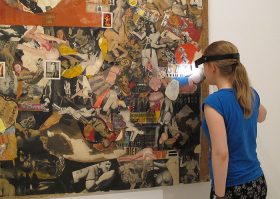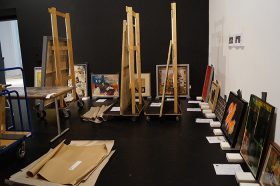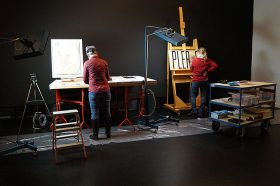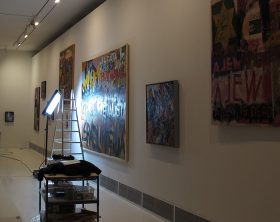Conservation Work on the Boris Lurie Exhibition

Conservator Alicija Steczek in front of a work of Boris Lurie; Jewish Museum Berlin, photo: Stephan Lohrengel
Visitors to our exhibition “No Compromises! The Art of Boris Lurie” (further information on our website) do not usually realize that they are viewing the result of lengthy groundwork and complex collaboration between various divisions of the museum. Those involved include, among others, employees of the temporary exhibition department, the registrars who for example take care of loans and organize shipments, and us conservators. We were already on board a year and a half before the exhibition was installed. Our work continues for the duration, only coming to an end with the closing and removal of the show in early August.
Boris Lurie’s art is fascinating and very variegated as to materials. Our work to protect it is thus correspondingly elaborate. Many of the pieces are collages and assemblages in which Lurie combined a wide variety of types of papers, photographs, oils and acrylic paints, often overlapping one another. Each of these materials has its own characteristics, reacting differently to fluctuations in climate or physical shocks. This turns the protective packaging for transport, careful handling during installation and removal, and continual air-conditioning of the exhibition rooms into central concerns. As conservators, we need to take care that these requirements are absolutely complied with, before, during, and after the exhibition. Only thus will we be able to leave Boris Lurie’s art for future generations to study and enjoy.
Hence precise logistical organization of the exhibition’s installation and removal is vital, starting as early as the planning phase. The various museum departments need closely to coordinate their work. In the case of Lurie’s artwork it was important to consider that some pieces would not be behind glass and would therefore require special safeguards in the exhibition. Moreover, some of the works didn’t fit into the elevator and thus had to be transported via the stairs to the exhibition space.
After the planning phase, construction began on the exhibition rooms, which had to be closed off before Lurie’s works could be brought in. That meant that the floor had to be covered, additional walls installed, painted, and dried, the space thoroughly cleaned, and the climate in the rooms stabilized.
Boris Lurie’s works arrived at last in the exhibition space inside their transportation crates. Once they were unpacked we could begin documenting each individual object: the condition of over 200 items was recorded with written descriptions as well as drawings and photographs, in so-called condition reports. We use our experience and expertise to evaluate damaged or potentially endangered sections of the artworks. For Lurie’s large collages it took some hours before the reports were complete. Only then could the pieces be hung by a professional installation team, which has experience in handling works of art and culture, in close collaboration with us conservation specialists.
Once all the artworks were hanging in their final positions, the lighting for each one could be arranged. Here too there are conservation issues in addition to aesthetic demands, because organic materials such as paper react especially sensitively to strong artificial or simply the wrong kind of light. Thus such works can only be displayed under reduced lighting.
My job as conservator was not finished, however, with the opening of the exhibition: the works need to be monitored regularly for the duration of the show. To protect the objects we dust the frames and pedestals as well as check on the air-conditioning and other conditions throughout the show.
When the exhibition closes three weeks from today, the entire process will be carried out in reverse: we will once again produce reports on all 206 works by Boris Lurie, examining the condition of each one. Then the objects will be gently wrapped, packed in their transport crates just as they were for the original shipment, and sent back to the lender in New York, the Boris Lurie Foundation.
For conservators, post-exhibition is also pre-exhibition: in September our next big exhibition “Golem” (more information) opens and we are already in the middle of preparations.
As a paper conservator Alicija Steczek was able to study Boris Lurie’s works particularly closely.


